Nicola Griffith's Blog, page 39
April 15, 2021
Fuck off into the sun: I’m done with being excluded
Right now many people are examining their culture—their workplace, their classroom, their creative writing workshop, their boardroom, their police force, their government entity, or their nonprofit—in order to make it more diverse, inclusive, and equitable. This is good. This is important. This is necessary.
In the last month I’ve talked—unpaid—to three literary organisations about some of their barriers to DEI as I see it. I spent time and energy I don’t really have, and don’t begrudge it, because—it’s worth repeating—it’s good, important, necessary work.
That is, I didn’t begrudge the time, effort and energy until I began to get the earnest (and to some degree self-congratulatory) follow-up emails from the organisations. They explain at length just how, after lengthy, expensive, weighty consultation, they’re going to go about improving their DEI efforts with regard to race, class, gender, and sexual orientation.
Great! Wonderful! All those things matter to me; they matter a great deal; I agree with every single category on the list. But every time—EVERY FUCKING TIME—one extremely important factor is missing from the list of traditionally marginalised people: disability.
Disabled writers matter. Disabled voices matter. Crip voices are the most—not one of the most, but the absolute MOST—ignored, devalued, and unheard on the fucking planet. (Read my Op-Ed in the New York Times.)* Disabled students (and teachers) are still—in 20-fucking-21—not able to properly attend many writing workshops, bookstores, classes, conferences, and festivals. We are shut out. Not only are we not offered places, we aren’t offered grants, we aren’t offered scholarships, we aren’t offered accommodations, and our applications aren’t offered the courtesy of being read by disabled readers. AND EVEN WHEN WE TALK OURSELVES BLUE IN THE FACE TO WELL-PAID DIVERSITY CONSULTANTS OUR POINTS OF VIEW ARE NOT FUCKING DEEMED WORTHY OF EVEN BEING LISTED IN THE SUMMARY DOCUMENTS.
So I’m done. You want my opinion on anything that’s not my own work? Pay me my weight in gold and expect to get an earful. Or better yet just fuck off into the sun.
*We’re also the demographic most abused at home; the most murdered by caregivers; the most badly paid; the most discriminated against by employers; the most laughed at in public; the poorest; the most refused transport on buses, trains, and planes; the least educated; and the most killed by law enforcement. We are 25% of the fucking population. This post isn’t a game of My Oppression is Worse Than Yours but I want to be super fucking clear that a) we’re not talking about one or two minor examples of discrimination here, and b) it doesn’t affect just a handful of people. ETA: Yes, there are data. No, I’m not going to do the unpaid work of providing them to you. Find them yourself.
April 13, 2021
Helena + Nicola = A Whole Psychopath
Today would have been the 57th birthday of my little sister, Helena. She died at the age of 24. She had had a history of drug use, abuse, and dependency (heroin, hash, meth), had been in trouble with the police from age 13, and been diagnosed with Borderline Personality Disorder. In 1988 she died in Australia after stealing a car and doctor’s bag and being flung through the windscreen at speed during a police chase.
She was three and half years younger than me. We were both much younger than our other sisters and were, functionally, a different pod; in that sense I was very much the older sister—almost a mother to Helena. We were very close; she shared many parts of my life that no one else ever knew. When she died in 1988 there was no longer anyone in the world who knew those things about me; it felt as though a huge part of me had died with her.
So today for no other reason than that I’d like to see them all in one place, here are some photos of her and me.
The first is taken on the beach at Filey, Yorkshire; my mother is holding Helena who is probably four months old. I’m three, almost four.
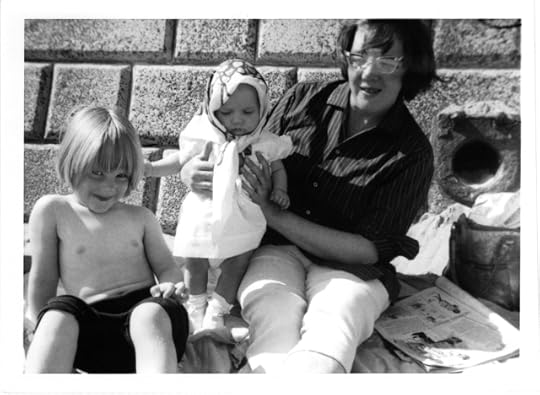 Filey beach
Filey beachThis one’s taken outside the bungalow we rented every year for two weeks in summer, in Hunmanby Gap—just a few miles from Filey. Standing by the old Ford Zephyr is my second-eldest sister, Carolyn, with me sitting on a football wearing shades, and Helena with her bucket and spades, ready to get to the beach. I’m guessing she’s three and I’m six. Carolyn would have been about fourteen—just before she started having psychotic episodes (most of my sisters have, or have had, serious emotional and psychological struggles—Carolyn, too, died young).
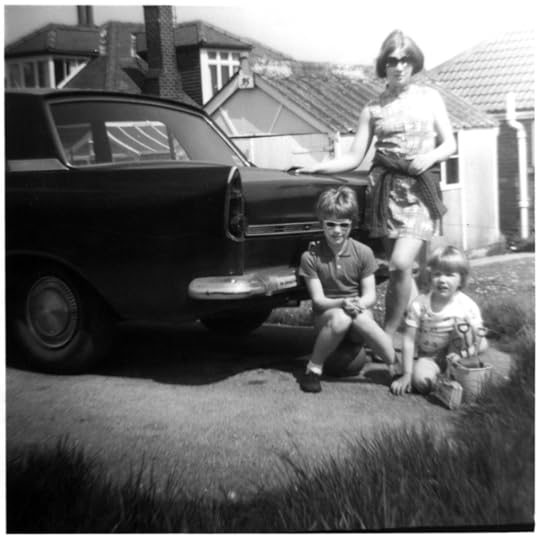 Hunmanby Gap
Hunmanby GapThis is just a couple of years later. Helena (front) and I are in the river at either Bolton Abbey or Fountains abbey. Bolton Abbey was the setting for the very first novel I tried to write, aged nine, about a girl who discovered a Ouija board in an Olde Curisoity Shoppe and ends up travelling back in time to the abbey’s heyday. (It was built in the 12th century but at that age I just knew it was a Long Time Ago.) I remembered writing very carefully and specifically about the stepping stones across the river…
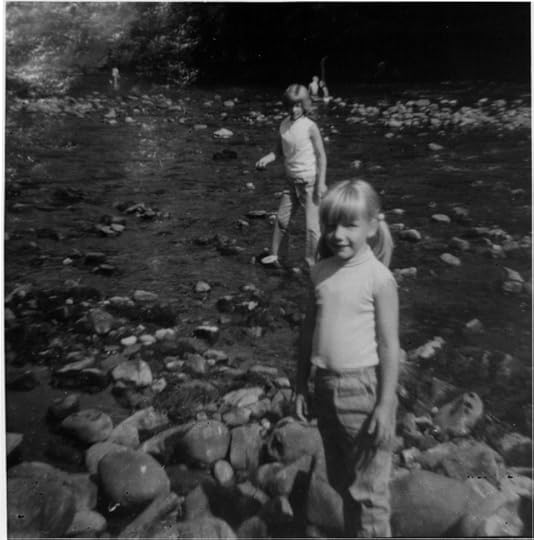 Bolton Abbey (or maybe Fountains Abbey)
Bolton Abbey (or maybe Fountains Abbey)Here Helena has just take her first Holy Communion: she’s the one looking like a perfect little angel (she was not) looking at the camera, aged seven. Standing behind her are my eldest sister Anne, my mother, me, and my third sister Julie. I’m ten. I’m always struck by this photo, and how protective I am of Helena; that is, although I always knew I was protective, I had no idea it showed so clearly.
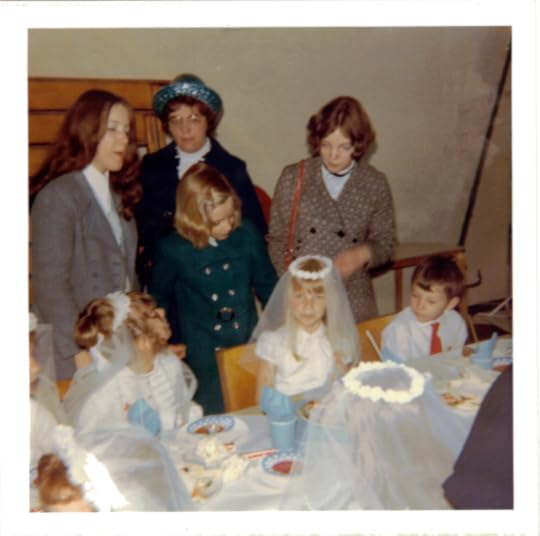 St Paul’s church hall, Leeds
St Paul’s church hall, LeedsAnd here we are in a school photo taken just a few months later. I love this photo; it captures how I like to remember her, how close we were, how we were everything to each other.
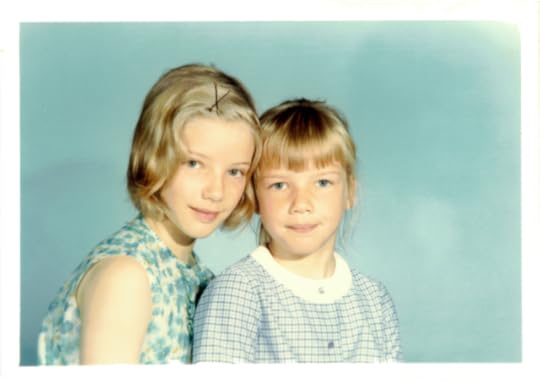 St Paul’s school, Leeds
St Paul’s school, LeedsThis one—I’m…well, I’m not sure how old I am. Younger, I think, than I look. Twelve or perhaps thirteen, which means Julie (back to camera) is either 18 or 19 and Helena is either nine or ten. By this she time had already started to show a few disturbing tendencies—pulling the legs off spiders and watching them struggle, stealing things—but no one else had noticed and I was still pretending there was nothing wrong.
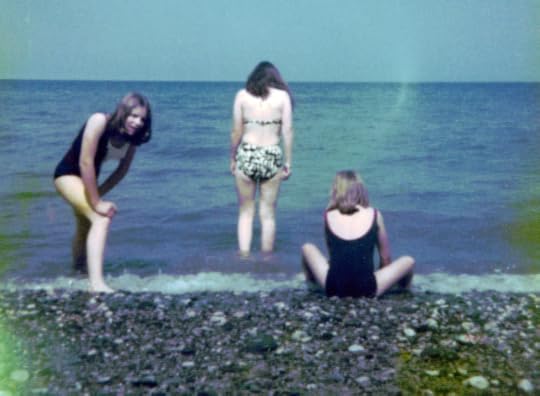 Somewhere in Somerset or Cornwall
Somewhere in Somerset or CornwallBy this time it was super clear there was something wrong: she was already using a variety of drugs, shoplifting, and had left home and school the first time at age 15. Here she’s 16, I think; I don’t know who took the photo; I was living in another city.
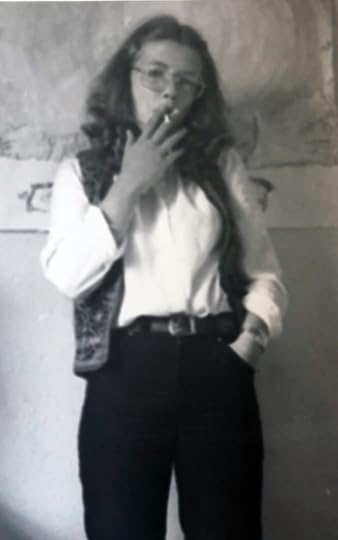 Place unknown
Place unknownAll the above photos came to me after my father died a couple of years ago. The three below were taken by Heidi Griffiths, my friend (no relation), and Helena’s lover, in Hull, in 1981. She gave them to me some time after Helena’s death. They’re the most recent photos I have of Helena because after she died my mother—crazy with grief—demanded I give her every single photo of Helena I had. I did. I never go them back.
In this photo I’m twenty, she’s seventeen—during a brief hiatus in the long, horrible descent into horror: Helena had come back home, was temporarily off drugs, and trying hard to be what she considered normal. But neither she nor I were ever ‘normal,’ so, well, it was never going to work. One of the essays in my memoir is titled, “A Whole Psychopath,” about how between us Helena and I displayed the classic Macdonald Triad of psychopathy symptoms. To be clear, I think that theory does not hold up, but it’s always been an easy shorthand to explain our childhood. However much credence you give the idea, I seemed to have turned out okay but Helena did not get the chance.
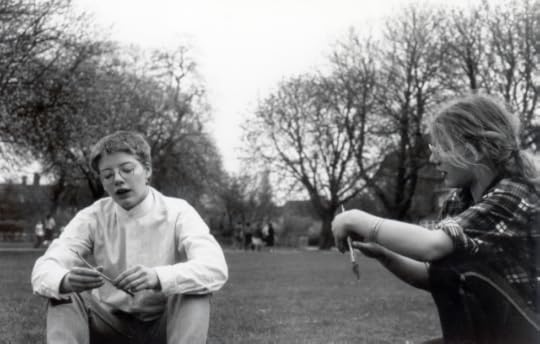 Pearson Park, Hull
Pearson Park, HullThis was taken the same day. Helena and I were both annoyingly fit and sporty even though we smoked and drank and took drugs a lot. In fact, if I recall correctly I had a terrible hangover that day…
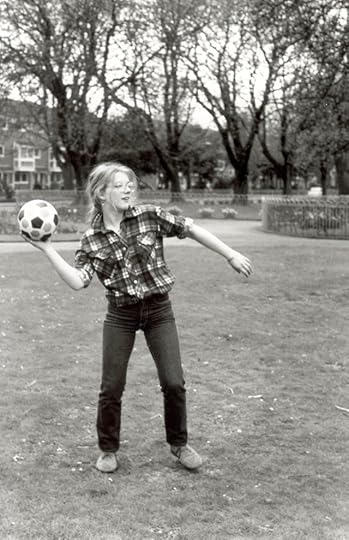 Pearson Park, Hull
Pearson Park, HullAnd here’s a closeup of Helena using my tobacco to roll her own cigarette. Even then, living in different cities, what was mine was hers, and what was hers was mine. (We even traded lovers a couple of times.) This is the last image of her I have, and this is how I prefer to remember her, before she grew rail thin, and hard, and paranoid enough to keep—and use—a machete by the front door.
 Pearson Park, Hull
Pearson Park, HullI often wonder whether, if she had not been killed in that car crash, she might have managed to survive into her thirties. I’ve known, and worked with, many users and former users, and sometimes if you can just get past your early thirties the odds of survival go up. But I’ll never know.
What would she be like at age 57? I’ll never know that, either.
I miss her still.
April 11, 2021
Hild through others’ eyes
Over the last few years I’ve seen a lot of art inspired by my novel—collected here—but the image below was made by Elena M.P. Cajal, a Spanish photographer, based not on the novel itself but on my blog posts about the novel.* Elena has kindly given me permission to use it here.
 Photomontage by Elena M.P. Cajal
Photomontage by Elena M.P. Cajal It’s part of an exhibition, Mujeres Poderosas, “Powerful Women: Forgotten by history and religion,” a series of large historical photomontages currently on display at the Palacio de la Isla (Burgos, northern Spain), with images of women like Hild, Hatshepsut, Wu Zetian and Sappho.
This image of Hild, of course, owes a great deal to later legends (that ammonite, for example, is based on the later medieval story of Hild turning all the local snakes to stone). The background image of Whitby shows the ruins of the stone abbey rebuilt in the 13th century, and the harbour, improved many times over the centuries—the first stone pier went up in the 17th century, and its final form took shape towards the end of the 19th century and beginning of the 20th. One image I would like to have seen added to the montage is a seagull soaring over the abbey: an acknowledgement of another legend that seagulls dip their wings in honour of Hild whenever they fly over the cliffs. There again there’s the quill pen, so perhaps that’s close enough.
Whitby is one of the few spots in Britain where you can watch the sun both rise and set over the sea (the cliff faces north) but that is not its only magic. If you ever get the chance to visit, do; perhaps you’ll feel the same rush of history fisting up through the turf that I did, a feeling so strong it drove me write about the woman who made the place famous.
*Why? Because Hild does not have a Spanish translation. Why? Because it’s very long, and as well as having to turn modern English into Spanish, the translator would also have to tackle Latin, Old English, Brythonic (that is, my approximation of same based on Old Welsh and bits of Cumbric) and Old Irish. And so far no Spanish publisher has considered it worth the risk.
April 10, 2021
Catching up
I’ve been meaning to do a post for a while but keep forgetting. Then today I got yet another Hey, you haven’t blogged for a while, are you okay? ping and realised it really has been a while.
So. What’s going on? Many things, none of them particularly terrible or wonderful. But since I turned in two books at once, then did a series of edits, I’ve just been loafing about. And it turns out that loafing becomes addictive; I’ve found I just can’t be bothered to do much of anything.
Having said all that, of course, it’s not the whole story. Part of the reason I can’t be bothered with stuff is that I’m extremely tired. This is the result of a combination of factors.
First of all, the vaccine. I am now more than a month past my second Moderna shot and, coincidentally (or not—channel Leonard Nimoy), after the first shot my energy levels dropped noticeably. After the second, they crashed. I also developed shocking muscle weakness that is only just now beginning to fade, and—O Joy!—suffered the Very Special Migraine* that usually hits me only once every two or three years. This time, though, I had 2 bouts in 10 days. By Very Special I mean I become temporarily blind, confused, and aphasic; that phase lasts about 40 minutes. It’s terrifying, because usually I have them so rarely I forget their existence and it takes a while to recognise what’s going on. So I’m in the middle of a conversation, or just getting myself a cup of tea, or taking a Zoom call, or some damn thing, and suddenly a sparkling, spiky anemone appears in the middle of someone’s face, the screen seems to burn from the top right corner, and I’m thinking, Wait, what? and just as I realise what’s happening I lose the power of coherent speech and can’t even tell people that, hey, I can’t see and words have no meaning. The second time it happened this time I recognised it instantly, had time to say, Sorry, migraine, gotta go and find the End Meeting button before I was stuck, unable to see or speak, on my office chair for half an hour while Charlie yowled and wanted to know where his food was. Then second phase is the headache and noise and ight sensitivity which lasts about four hours, followed by the third phase, which is at least 18 hours of exhaustion. No one really knows what causes them—the usual list of suspects includes bright light, caffeine, lack of sleep, weather, stress, and ‘some medications’—but given that I’ve never before had 2 of them in 10 days, or 2 jabs in 28 days, and then got them both at the same time, then, well, screw Correlation Is Not Causation: I blame the jab.
But here’s the thing: DESPITE MY REACTION I WOULD TOTALLY GET THE JAB AGAIN. Migraine sucks, and exhaustion sucks, but death sucks harder. And perhaps being responsible for a loved one’s death would suck hardest of all. All this reaction shit passes; death does not. So if you’re dithering, stop it; go get your shot.
So, yeah, anyway, there’s that.
The second factor is something that occurs to some degree every year at this time: tree pollen and its attendant allergies. Some years are worse than others. To be clear, when I talk about allergies in this context I don’t mean itchy eyes or runny nose—though of course I get those too—I mean a serious system upset. My blood oxygen can fall (92 is not unusual), my heartbeat becomes disordered (I can faint). My blood pressure doesn’t seem to know whether it should shoot up or fall down, or, hey, maybe both in the space of 15 seconds. I can’t regulate my body temperature. Over the years and after a series of doctors, the most likely explanation is that my histamine/mast cell response mechanisms don’t work properly. Most of the time it’s just irritating, inconvenient, and immiserating, but, with care and attention, mostly controllable. Occasionally, though, it’s disabling. And this year, of course, a very high pollen count just happened to coincide with vaccine season.
So, yeah, there’s that.
The third factor is a whole bunch of family stuff but that’s not my story to tell, except to say I’m feeling a bit worn down.
And yet: The sun is shining! Birds are singing! Charlie and George are in fine form! (I’ll probably do a post about their birthday next month.) I cashed a very tasty option cheque a week or two ago! (I can’t talk about that, though.) The fridge is groaning with delicious food, the counter is loaded with wine, we (still, mostly) have grownups in charge of the country! (Y’know, when they’re allowed to get anything done, of course—but, oh, don’t get me started on that.)
When you combine those with the fact that both Kelley and I are fully vaccinated and in this part of the country at least vaccination is accelerating, I am feeling hopeful that we could be on track to something resembling normal life by autumn. (I’ll be writing about that soon, too.)
Basically, right now is pretty fabulous in many ways, I’m just not focused on talking to the outside world.
So what have I been doing? Well, I haven’t been writing, and it feels odd. But I’m beginning to consider two projects (which, again, I might talk about soon in another blog post).
I’ve been doing the occasional appearance/reading/authorly thing, most recently at ICFA where I read from Spear. I’ve already posted a tiny snippet of one reading, and at some point I’ll get around to uploading and captioning the rest of it, plus another, longer reading. Again, that will be another blog post.
One thing I’ve started to do is experiment with various image and art apps, and I’ve been playing around with making some Hild-related images. That, too, will be a future blog post.
And finally I’ve been reading. Mostly it’s been research that I couldn’t get to during my galloping productivity last year, but also some fiction. And that will be yet another blog post: a handful of books to look for in the next month.
So basically: I’ve been tired, I’m feeling better, and lots of blog posts will be coming soon.
*Migraine with Brainstem Aura, formerly known as Basilar Artery Migraines
March 15, 2021
A 3-minute video reading from Spear
In which I read the first 3 minutes of my new (my first!) fantasy, Spear
If it weren’t for this pandemic, next week I’d be in Florida for the 42nd annual International Conference on the Fantastic in the Arts. Instead, I’ve uploaded a two-part reading from Spear—a little bit from the beginning and a longer scene from the middle of the book in which Peretur, with her stolen and mended armour, bony gelding, and broken sword, faces the Red Knight.
Those who have registered for the conference will be able to see the whole thing, already recorded and uploaded, plus the live Q&A on Saturday at 3pm Eastern hosted by E. Lily Yu and featuring me and fellow readers Karen Joy Fowler, Molly Tanzer, and Rachel Steiger-Meister.
Come and ask questions! I’m dying to talk about this book…
February 24, 2021
Workshop: Character through setting, Monday March 15
EDIT: All paid places are sold out but a couple of scholarship places remain. So if you’re BIPOC or disabled, please apply!
In a little over two weeks I’ll be teaching a two-hour Zoom workshop for Clarion West on using setting to explore your character—and character to explore your setting. The class is designed for writers of any genre and level of experience.How we describe a place and our character’s actions within it can tell the reader much of what they need to know: who the protagonist is, how they got there, and how they feel. Learn to find your way deep into your character—while drawing the reader deeper into your world. Come prepared for listening, writing, and talking.
The class runs 120 minutes, from 4:00pm – 6:00 pm Pacific time, Monday 15th March. It costs $55, though there are some scholarships available for writers who are BIPOC and/or from other traditionally marginalised backgrounds. Book here, through Eventbrite, because I’m not sure when/if it’ll go up on the Clarion West website. You should check out the CW site, though, for other classes and workshops. Some are free, and many look marvellous.
Space is limited so if you’re interested please book soon. The reason I’ve limited the class is that my preferred teaching mode is interactive: discussion, questions, answers, writing exercises, discussion, explanation. It will be the same on Zoom: I’ll talk for five minutes, we’ll write something, break into small groups, talk, come back to the main group, figure out what we’ve learnt; rinse; repeat. It’s hard to do that with a 100 people.
I’m still in the planning stages—figuring out how best to use Zoom—but right now I’ll want participants to bring just two things:
An idea of your favourite fictional character—not a character you admire but one you love; one whose company makes you happy when you long to shut out the world and just dive into story for a while. A favourite moment with that character—it could be a whole scene, or just a moment, a feeling, a sentence; you choose.It could be a kid from The Drawing of the Dark, Anna Karenina, the horse from My Friend Flicka, or the sacrificial Giving Tree. It doesn’t matter; what matters is how you feel about this person (or animal, or tree). But I’ll want that firm in your minds.
Bring questions, too, if you have them, whether about setting or character—for me the two are intimately intertwined. And come, of course, with that mix of willingness to play and work that makes for the best learning.
February 12, 2021
Menewood progress
Menewood has now been rewritten twice and is in the hands of my editor and agent. It’s a long book, so it’ll take a while to read. Then they’ll both have to do some thinking before I get edit letters. Then I’ll have to read the letters and think about those. Then I’ll have to rewrite it once or twice more (with ensuing rounds of reading, editing, thinking, etc). Then there’s all the paratext to prepare: the maps and glossary and family trees and so on. Deciding cover art, cover copy. Catalogue copy. Copyediting—which for Hild took three rounds. Then proofing—don’t even try to count those. Bound galleys, Advance Reading Copies, pre-publicity, publicity, and finally: Launch! At which point it gets really busy…
You’ll understand, then, why I have absolutely no clue of a publication date.
However, if I were Empress of the Universe I’d plump for November 14, 2022—right before St Hild’s feast day, and almost exactly 9 years after the publication of Hild. But on top of the novel’s insane length, there are so many things to consider, such as the fact that I already have a book coming out in 2022—Spear, due from Tordotcom in April—and there are the three Aud novels which await reissue. Not to mention the collection of short fiction which is almost ready to go.
So while I want it to be 2022, Menewood might not appear until 2023.
So as a tiny little treat I’ve written a map-heavy post about Cadwallon—his origins, battles, and faults. It’s going up on Gemæcce, my research blog, on Friday morning, and includes juicy little details about events in Menewood. Fair warning, though: if you’re not familiar with the broad Wikipedia-level outlines of British history c. 631-635 you might find it a bit spoilerish.
If you do choose to go read it, you’ll see I’ve been experimenting with map styles and beginning to lean more towards topographical maps which ultimately make the most sense in this context. I’ve used various types and levels of stylisation and am curious about which readers prefer.
Enjoy. And let me know—either here or over at Gemæcce.
January 26, 2021
Queer Early Medieval: LGBTQ+ History Month
M Shed, part of Bristol Museums, is celebrating LGBTQ+ History Month in February with four free events. As part of that series I’ll be talking to Cheryl Morgan on 16th February at 7pm UK time (11 am West Coast). We’ll talk about sexuality and gender in seventh-century Britain—and in Roman Britain—and how Christianity did and did not have an impact on Hild and her people’s attitudes. It’s free, and it’s on Zoom. I hope you drop in and ask a question or two—seriously, ask questions! I love to answer questions! And hey, maybe I’ll talk a bit about Menewood, too. Register here.
About the eventFrom M-Shed:
Saint Hilda of Whitby is a key figure in the history of Christianity in early Britain. Born into a royal family in Northumbria in 614 CE, Hilda entered the church and founded Whitby Abbey.
There she hosted the Synod of Whitby, in which clergy from the British and Roman branches of the Christian Church met to debate the then disputed question of how to calculate the date of Easter.
In her historical novel, Hild, based on the early life of the saint, award-winning novelist Nicola Griffith chose to make her heroine bisexual.
In this event, Griffith will be in conversation with historian, Cheryl Morgan. They will talk about the research underpinning the novel, and how we understand ideas of sexuality and gender in the ancient and early-medieval world.
They will address the perils of assuming a linear progression of attitudes from the past to the present day—tolerance is not a purely 21st-century characteristic.
Nicola Griffith grew up in Yorkshire, but now lives in Seattle with her wife and fellow writer, Kelley Eskridge. Griffith has a successful career in writing novels and memoir, and editing anthologies of original queer fiction. She has won multiple awards, including six from the Lambda Literary Foundation for books with LGBTQ+ themes.
Speaker: Nicola Griffith, award-winning novelist, in conversation with Cheryl Morgan, historian and co-chair of Outstories Bristol
How to RegisterWhen: 16th February, 7pm UK time (11 am Pacific)
Where: Zoom
Cost: Free!
How: Register here
January 20, 2021
A Good Feeling
It’s a good feeling to be able to follow @POTUS again on Twitter and know sudden, shocking blood pressure spikes will not blow the top of my head off. (I have perfectly normal BP, except when I see a picture or hear the voice of Trump. It got so bad that I could longer listen to the radio in the car for dread of that voice suddenly catapulting me into rage.)
It’s a good feeling to be able to write a blog post whenever I want without having to worry the Secret Service might start taking an interest because I sound unhinged. (If I still lived in the UK I wouldn’t have worried about such things, but I spent so many years watching my Ps and Qs going through the US immigration process caution became ingrained.)
It’s a good feeling to watch the first Latina Supreme Court Justice administer the oath to a Black female Vice President. (It was difficult watching the last two justices get confirmed despite their clear unsuitability. Gorsuch isn’t exactly a prize, either, but not as blatantly vile as the other two.)
It’s a fantastic fucking feeling to see a Black woman become Vice President. It’s thrilling knowing she’s relatively young with a stellar path before her. I do sincerely hope—and if I prayed, I’d pray—that one day she gets the top job with the short oath. (The VP’s oath is the same one members of Congress and the Cabinet take, whereas the President gets their own, special, mandated-by-the-Constitution oath.)
It’s a heart-fillingly good feeling to see Joe Biden sworn in as the 46th President of the United States. It’s a relief to hear his speech about honour, decency, unity, and truth. For one brief moment I actually believed it might just be possible to start fixing some of the horrors of the past. I hope it is possible. But at the very least it makes a vast huge difference knowing that the people in charge are no longer malevolent narcissists aided and abetted by venal criminals.
It’s a profoundly gratifying feeling to see a young Black woman stand before the world, full of promise and joy and strength, and—like Greta Thunberg, like Emma González—speak intellectual and emotional truth with a moving and powerful voice.
It feels astoundingly good—I feel astoundingly good—to hope again. I’m still cautious with my hope, but I’ll keep trying. Between us, may we be lucky enough to succeed.
January 18, 2021
Kitten Report #17: Songbird Fever
Spoiler: the kitties are fine, better than fine.
New Year’s Eve dawned upon a great slaughter. Charlie and George turned the house into an abattoir: two moles, one vole, and a bird. It was Charlie who caught most of them—including the bird—and George who ate them—including the bird. The bird, in particular, was messy. Charlie brought it in recently-dead, and proceeded to toss it around and get feathers everywhere.

Nope, wasn’t me
Then he threw it into the Christmas tree, where it got stuck. So of course he had to pull off ornaments (one shattered) and countless branchlets and pine needles to get to it. After a while, though—once he’d got feathers stuck in his mouth a few more times—he got bored, as he always does, and abandoned the bird for his dish of real kitty food.
Enter George. He threw that thing around with enthusiasm, leaping, tossing, catching, pouncing, and then—again, as he always does—he settled in to eat it. The feathers—and beak—were a challenge so he left those and what seemed to be a crop and assorted tubules in a glistening pile on our white (oh yes) carpet. Then he, too, went to eat real food.
We cleaned everything up, had our usual private and lovely New Year’s Eve celebration that begins with Champagne and caviar and conversation, and went to bed. The fireworks were a nuisance: they were the loudest I remember—and after recent events I was sympathetic of the urge to make a joyful noise, but it was like the Battle of the fucking Somme out there. Charlie jumped the first time then settled on the bed unfazed; George was nervous for an hour—or what I thought was nervous. But then they slept, so then I could sleep—about 3 a.m.
We woke up the next morning to a vast steaming pile of vomit on the white carpet, full of feathers and bird feet. (Happy New Year!) George didn’t want to eat anything—but we weren’t worried: he’d eaten a lot the day before (lots of catfood, a bird and a shrew). They both went outside and ran around, came back, played, had lap time—the usual. But then George started moving slowly, and he still didn’t eat. There was clearly something not right, but we didn’t know what. I began to fret that maybe Charlie had found a bird that was already dead of some kind of poison. But George wasn’t hiding, he wasn’t vomiting, he was just not eating and moving very slowly. But, oh, he looked pitiful.

George feels woebegone
On most days, we would have called the vet and tried to get an emergency appointment. George is a jumpy cat, and we always take him to a veterinary practise that caters exclusively to cats (called, oddly enough, Cats Exclusive—a wonderful practice). But, well, holidays. So we resolved that if he wasn’t markedly improved by the next morning, we’d take him to the emergency 24-hour animal hospital, Blue Pearl. After all, he wasn’t bleeding, he didn’t appear to be in pain, and he was using the litter tray.
The next day, he was clearly worse. Off to the hospital he went. He had a very high fever. The vet suspected Salmonellosis—birdsong fever. I’d never heard of it, but it made complete sense. If the bird was already ill with Salmonella when Charlie came across it, it would explain why he’d been able to catch it—he’s been after birds for months but never managed to get one. But George was pretty ill, and apparently about 10% of cats with Salmonellosis die, so we were worried. They admitted him, and put him on IV fluids and antibiotics, and anti-nausea meds. They also did a lot of blood work. And an X-ray just in case he had some kind of intestinal blockage.
The results of these tests were not as clear as anyone would like, so they did some more.* His fever remained stubbornly high. He still wouldn’t eat. We were even more worried. But twelve hours after that, although he was still refusing to eat, his fever finally began to come down. George is a nervous cat, and the hospital was full of to-him dangerous animals like dogs; we were convinced that if we could just get him home he’s recover much faster. Eventually—late Monday night/early Tuesday morning—we managed to bring him home, along with a grab bag of meds: anti-nausea, antibiotic, and appetite stimulant. He’d lost a fair amount of weight (down to 11 lbs) but we were confident we could persuade him to eat.
At 12:30 a.m. he crept from his cat carrier, saw we were all there, that he was safe, and sat and cleaned himself nonstop for thirty minutes. Then he followed us to bed and crawled onto my lap, stuck his head under my arm, and fell straight into sleep. Awkward for me. I sat up for an hour just holding him while he twitched and mewed in a series of bad dreams. He had a shaved band on his right foreleg where they’d attached one IV—it looked startlingly like he was wearing a single, fashionable Ugg—and a shaved patch on his right rear foot where’s they’d put another. Just after 2 a.m. I was beginning to prepare myself for being the Mean Mom of the Year and to push a poor sick kitty off my lap so I could lie down and get some sleep, when he woke up, purred, and ambled over to where Charlie was sleeping at the foot of the bed. There he accepted a good head cleaning, and settled down to sleep again. He slept hard.
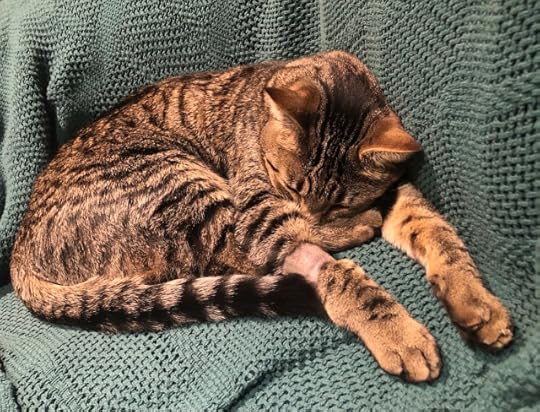
Ugg
The next day he was clearly fragile, still slow-moving, but he ate—not nearly as much as he would normally but definitely eating. Charlie, though, was driving us insane: He wanted to go out! Out! Out now! He was alternately stonking about in high dudgeon, knocking things down, and climbing high to find an alternate escape route. Oh, well, I told him. Maybe that will teach you not to bring home disease-riddled birds. He just glared.

Figuring out if he can reach the skylight
Meanwhile George made one sad and pitiful attempt to pat open the door swooned in exhaustion. The vet had suggested it might take four days or so for George to feel like himself again, so I wasn’t worried. I explained to Charlie that maybe, if he let George eat and sleep in peace, they could both go out in three or four days when he was better.
Oh, ha! Ha ha ha! At one o’clock that morning I was woken up by kitties in full knock-down, drag-out, chase-me-now mode, including the destruction of almost everything on a shelf or table top in the living room and family room. Fortunately we had just taken the tree down. When we got up in the morning, every single scrap of food was gone and George was yowling his head off for more. We fed them. George ate everything in two seconds flat. Yowled for more. Repeat. We let them out that lunchtime—just for two hours (they didn’t mind: it was cold). The day after, they were back to their usual routine.

G: You killed it while I was gone!
C: No, you killed it.
G: I wasn’t even here!
C: Dead, though.
G: Definitely dead.
There are days when they are obviously twins—

Conjoined twins

Window twins
—and days when it’s hard to believe they belong to the same species, never mind family. They have days when they look startlingly young—
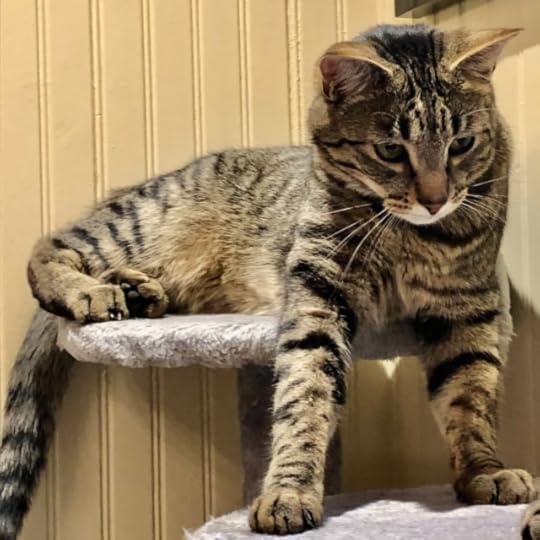
George no longer fits at the top of the kitty condo but every now and again he tries to revisit his youth
—and days when Charlie in particular looks old.

Charlie’s ennui is soothed only with a massage
Charlie saw fit to help with the Spear rewrite, but found the experience debilitating, so I was on my own with Menewood—probably why it went so fast.

Rewriting is so tiring
As I write, both cats are in fine fettle. They seem to have discovered a mole colony, and the daily round of rescuing the poor things is getting tedious—they don’t seem to kill them the way they do shrews and voles and mice, just bat them about—but both are currently in contentment mode.

George finds his bliss
In fact, George is mostly now so glad he’s not in the hospital that he almost glows.

George glows with contentment
May we all find such contentment in 2021. Meanwhile, if you need a break from doomscrolling and might be soothed by pictures of kitties, feel free to read previous Kitten Reports here.
*We got those results a couple of days later: he’s fine, completely normal.




